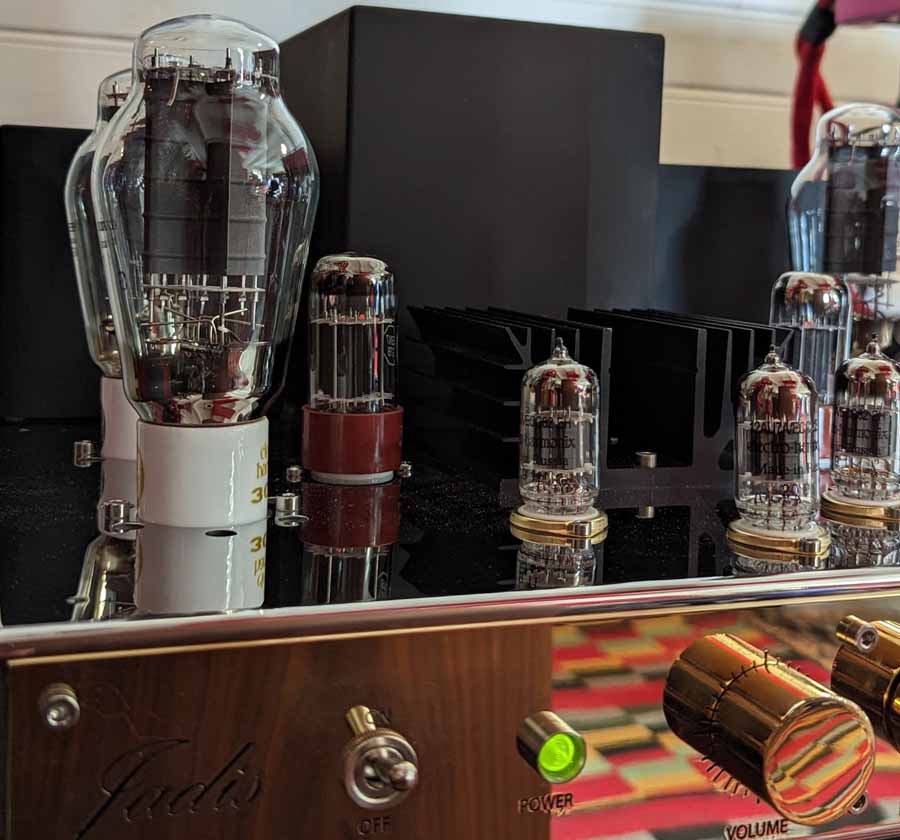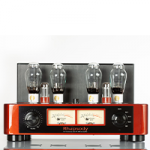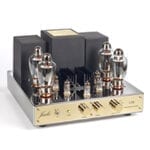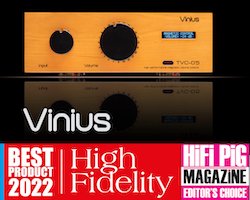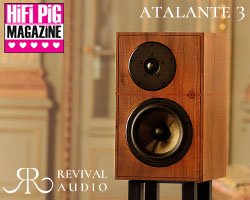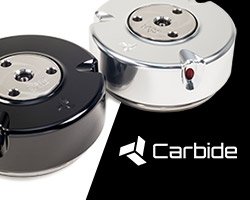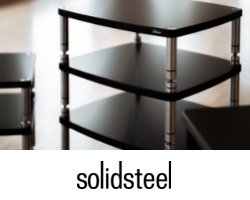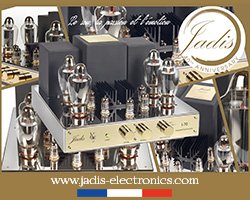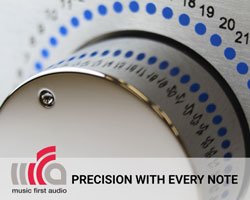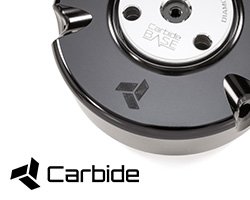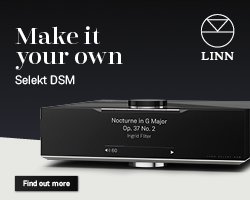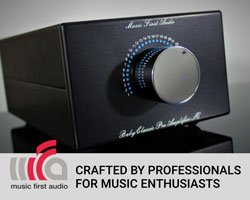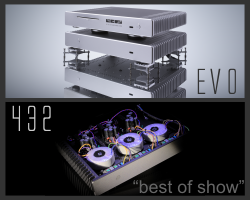JADIS I300 INTEGRATED AMPLIFIER REVIEW
The Jadis I300 is a 300B integrated amplifier with the power tubes in a push-pull configuration. Stu takes a listen. 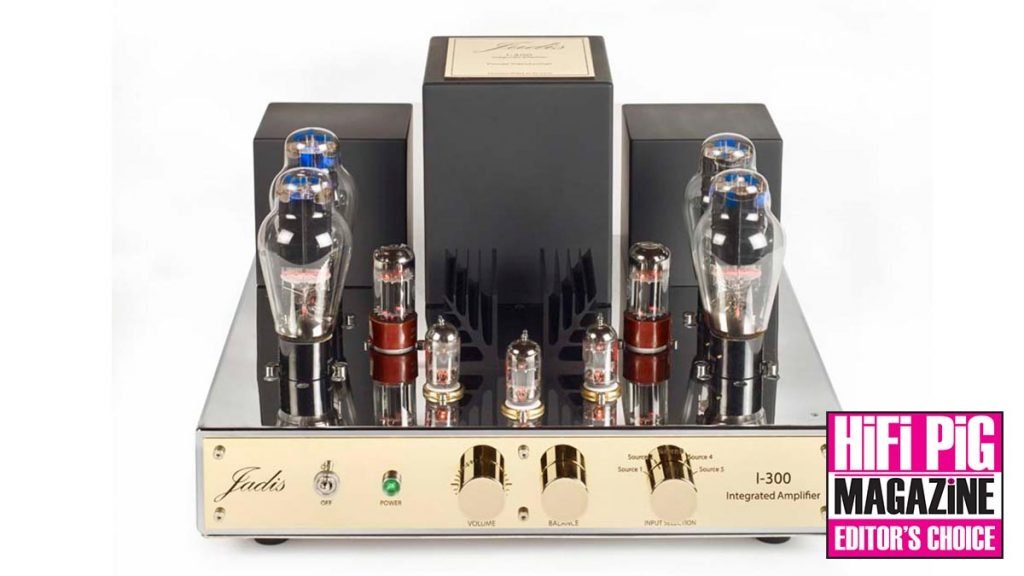
I was dreading this amplifier arriving from the very moment we agreed to review it, which if I recall was way back in May of 2022. Now, when I say I was dreading it, that’s a bit unfair on JADIS because I was actually really looking forward to placing this 300B tube integrated amplifier into one of our review systems, though I strongly suspected that there would be a strong likelihood that I’d never want it to leave, despite not needing another amplifier and, further, an integrated amplifier not being really all that useful for our specific (review) purposes at this moment in time. So, here and now, I declare that my preconceived ideas (expectation bias ahoy, mateys) around this amplifier were that it would be right up my particular street; my favourite tube is the 300B and my previous experience with JADIS amplifiers had been spectacularly positive – I loved the I70 amp I reviewed back in April 2022. However, my job is to put my excitement and expectation bias to one side and assess a product without prejudice and without any predetermined ideas about its performance, but I’m human and, of course, I get excited about products that I think are going to press all my personal aural buttons.
WHO ARE JADIS
JADIS is a French valve amplifier manufacturer based in Villedubert, South East of Toulouse in France. The company launched in 1983 following the success of prototypes built by André Calmettes and a desire to build amplifiers based on his philosophy for a wider audience. JADIS are best known for their amplifiers but they also produce CD players, DACs, and even turntables. Their signature colour is gold and whilst this may not appeal to everyone, it certainly sets JADIS products apart from the herd.
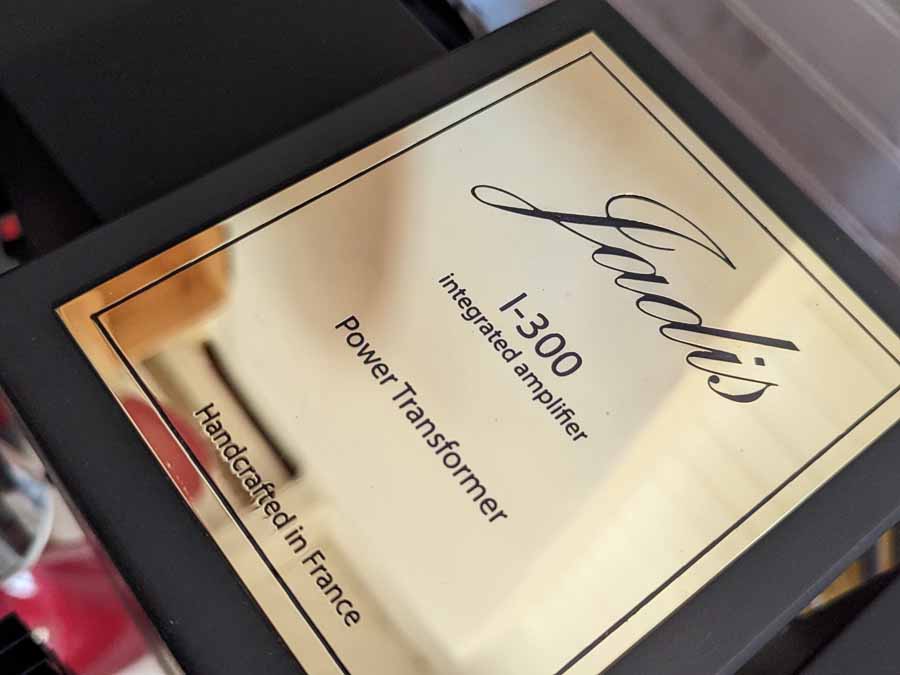
Even the transformers are dressed in their best.
JADIS I300 INTEGRATED AMPLIFIER BUILD AND FEATURES
There are two 300B valves per channel in the I300 and are mounted in a push-pull configuration without feedback. Given 300B specificities, Jadis says that they took particular care in creating the amplifier stating specifically that there was a need for a highly stable power supply for the heaters and adding that this design feature “allows the I300 to appear much more powerful than its 10W (a channel) may suggest!”.
“TEN WATTS?” I hear you scream “That’s not going to be much use with regular modern speakers” but let’s not discount this amplifier before we start because in my experience the whole concept of needing mega-power amplifiers is somewhat overstated and in the real world (we aren’t all trying to drive rooms with Royal Albert Hall proportions to ear-damaging volumes) the actual requirement of power (watts) is not actually all that high, particularly if you have reasonably sensitive speakers. These ten watts are however all in Class A!
The full valve complement is the four 300B tubes (2 per channel) a couple of 6SN7s (drive tubes) and three ECC82s (preamplification).
Every stage in the amp has its own power supply, and JADIS tells us that “particular care has been taken with the 300Bs themselves.” As directly heated triodes, the heater is the cathode and JADIS says that this requires a very “clean” power supply with them giving seven separate power circuits in this design. The one dedicated to the power supply uses a magnetic circuit (EI M6X) in a design that they say gives a very stable operation, without noise and with reduced overheating. The output transformer uses a double CV38 magnetic circuit built according to JADIS’ standards, and JADIS tells us that the I300 is the only integrated amplifier with an output transformer of this specific type.
Arriving in a huge flight case, the I300 maintains the JADIS family look and it is pretty blingtastic… and this may not appeal to everyone with current tastes for home decoration erring on the side of understated simplicity. But, the argument may well be that if you are spending €13,500 on an integrated amplifier, or any bit of audio kit, then you will want to show it off. At the expense of promoting conspicuous consumption, I fall in this latter category of audiophile. The amp is reassuringly heavy at a hernia-inducing 40kg, a pretty much standard kind of size (40 x 40 x 25.5 cm) and I think it looks fab.
On the front of the I300 amp you have, from left to right, an on-off toggle switch, an on-off LED, the volume knob, a balance knob, and finally the source selector. A balance control may appear to be a bit anachronistic but I am a fan of them and would encourage their inclusion on many more amplifiers than they are currently found on; balance controls allow for vagaries in-room balance and for imbalanced hearing.
The I300 is a line-level only preamplifier and there’s no onboard phonostage or DAC. This purist approach will appeal to most but may be seen as being a bit lacking on a modern-day integrated. I think, given the likely audience for this amplifier, that an onboard phono would have been a mistake and, given the rate at which DACs are developing/changing, a DAC would have been a bit daft too. Long story short, the I300 addresses the needs of its intended audience.
There are five inputs on RCA, a bypass output meaning that the amp could be used as a preamplifier, and a pair of speaker binding posts.
A remote control is included in the package and whilst it’s pretty basic, it does its job. I’d have loved to see a remote that was similar in design to the amplifier itself.
Everything on this amplifier suggests it is a high-quality product and that it is built to last! Longevity, or the lack of it, in some products from some brands is a bit of a bugbear of mine. If you are spending this kind of money on an amplifier (or anything, for that matter) then you would expect it to last pretty much a lifetime, with the caveat that an amplifier like this will probably need a service after ten years or so and, depending on how much use it gets, valves will need to be changed. Look, if you buy a decent automatic watch, you expect it to last forever, but you also factor in that it is going to last longer and work more accurately if it is serviced regularly. Whatever, the JADIS I300 is built to endure!
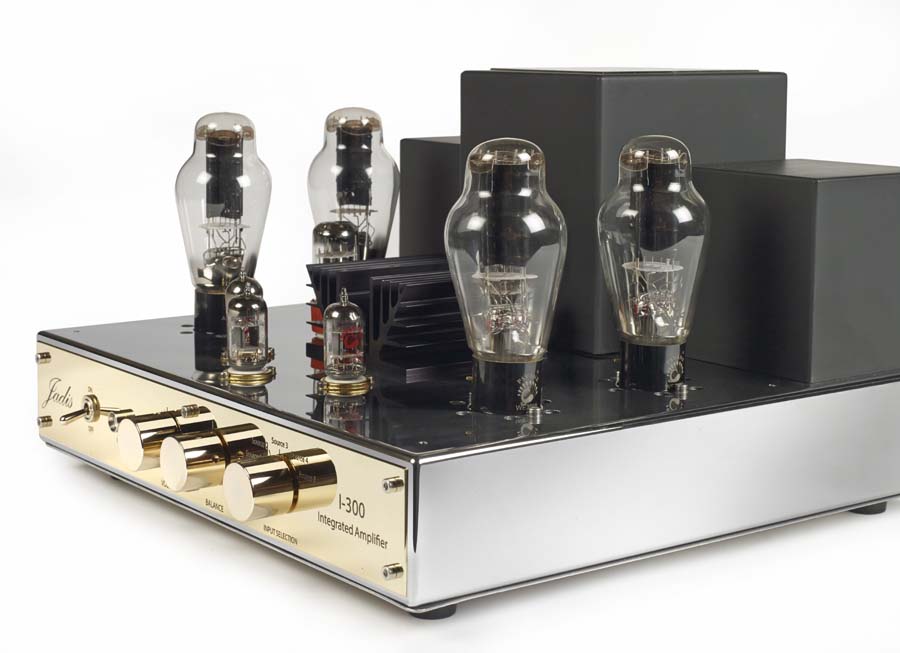
High polished chrome and gold accents look fantastic but may divide opinion.
SOUND OF THE JADIS I300 INTEGRATED AMPLIFIER
For the purposes of this review, I used the I300 with a Lampizator BIG7 DAC (hugely upgraded) and a variety of speakers ranging from our Avantgarde DUO XD, TOTAL DAC D100 and our Audiovector R6 Areté. The streamer was from Stack Audio and this was accompanied by a switch from Russ Andrews and various other “enhancements”. Cables were from Cardas, WAY, Tellurium Q, and Atlas with all powered components going through a Torus Power toroidal transformer-based “conditioner”.
I spent a fair old bit of time with the JADIS I300 hooked up to the Avantgarde Duo XDs and it’s a real treat to hear that wonderful mid-band tone and sweet lower tops that the 300B tube does so well. But I also played a whole load of house and techno through them and this was a bit of an indulgence – to the point of the Duos staying on the end of the amp much longer than they should have given the time I’d allotted to this review. Night after night I mixed through this setup, but these speakers are not ideal for review purposes given they have active bass modules and so, although a wonderful experience (both whilst mixing and whilst listening to tunes for pleasure), it wasn’t really giving me anything I could usefully convey to you, dear reader. What you do get is a delightfully smooth and yet articulate mid-band presentation that is fantastic with pretty much whatever music you throw at the pairing and the tops just integrate SO well with this amplifier in place. This is an excellent pairing to pamper yourself if you are able.
I also had the Total DAC S100s on the end of this amplifier and this pairing too was rather splendid with the amp showing that it can keep the bass drivers on these speakers well in check and in control whilst losing nothing of the amp’s sweet character. In my review of these speakers I did say that a 300B SET amp would be a great match and whilst this amp is in a Push-Pull configuration the two are a fantastic match which errs on the side of a more audiophile listen, majoring, as it does, in the mids and through the tops. I keep talking about how good this amp is in this band of frequencies, and it is, but what does that mean? With these speakers I mean that there is a complete lack of harshness and a flow to the music that sits you down and envelops you in a warm blanket of sound. It’s detailed without ruthlessness in the extremes of frequency and it’s softness without a feeling that anything is rolled off or missing. Hard to describe but it’s very nice to experience. These speakers stayed in the system for a fair old bit too and I had planned to carry out the whole of the review with them in place, but I also wanted to plug in the more conventional (in some ways) Audiovector R6 Arreté that I thought would be more of a challenge to this amp.
As it turned out these speakers gelled perfectly with the JADIS I300, something I wasn’t really expecting if I’m honest, though at 91.5dB sensitivity, they weren’t going to be a problem for the 10W JADIS. So, the majority of this review was done with these speakers in place, and from here on in it is this combo that I’m going to be talking about.
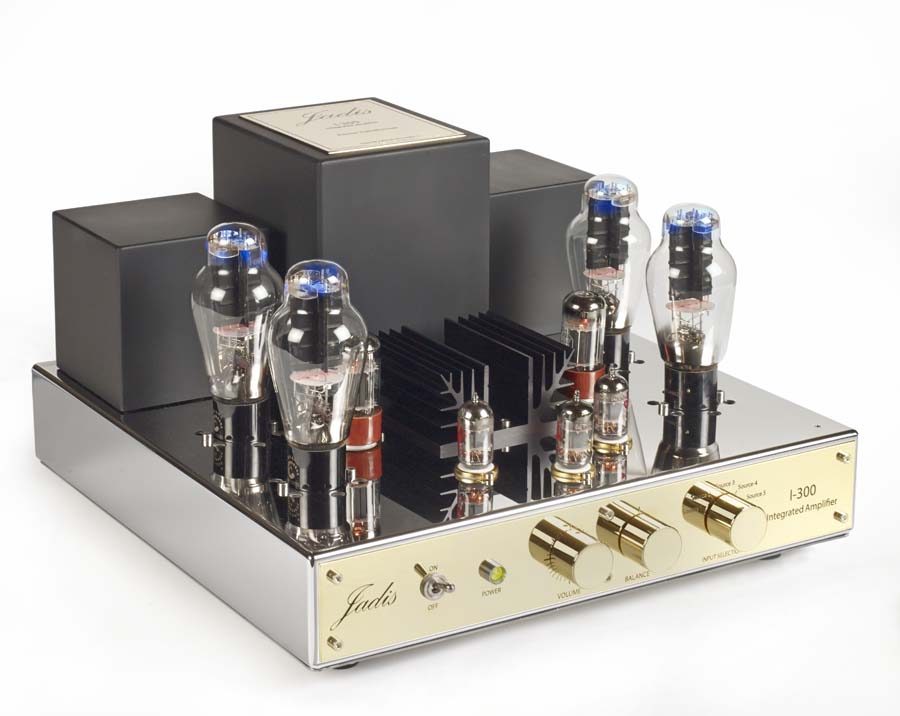
Two 300B power tubes per channel in push-pull.
As always I played a load more music throughout the review process than gets mentioned here but I’ll be picking out tunes and pieces that I think demonstrate the point (or feature of the amp and its sound) that I’m trying to convey.
Robag Wruhme’s No on Kompakt was first chosen as it has a lot going on from a spatial perspective but it also has a low and insistent bass line. That bass line and kick are handled splendidly by the amp with there being control but also a good deal of texture is evident. The effects like long reverbs and space around sounds are portrayed really well and it’s clear that whilst only having a relatively meagre ten watts a channel to its name, the JADIS doesn’t struggle dynamically. In fact, I’d say this is a wonderfully dynamic amplifier and I didn’t feel it ever ran out of steam, even when it was pushing these speakers to volumes that I’d suggest it unwise to listen to for all but relatively short periods. At these volumes, however, the amp really brought these speakers to life and conveyed an excellent sense of this being a techno tune made for the club. Spatially (again) the soundstage was wide deep and high with instruments holding their own in the space properly. I whacked a lot of techno through the R6 and I300 combination and I would say that technoheads are exceptionally well catered for. I mentioned the texture thing on the bass at the start of this paragraph and that carries through all the frequency range remarkably well. I would suggest that this isn’t a sterile amplifier, in that it isn’t absolutely neutral, and it does add a flavour of its own, but personally, I thoroughly enjoyed this ever so slightly “bloomy” through the mids feeling I got from the amp – particularly with these speakers.
Another favourite of mine to bring out for reviews is the excellent Ali Farka Touré’s Roucky. The idea is that I want to hear the sound of the strings of the guitars and the sound of the body of the guitar too. Bends on steel strings sound “in-the-room” lifelike. This is as good as I’ve heard this track in our system and that mid-band bloom (it’s not huge) adds something indefinable to the whole listening experience. Notes that are extended hang in the air and more staccato notes start and stop on a dime/penny/centime. Sounds on the fretboard and body of the guitar are unmistakable in the mix and everything sounds very right. There’s a natural and (review speak alert) organic sound to everything that I’m hearing and the amp is doing an amazing job at creating a magical listening experience. This is a good thing and what I think many want from their systems. Yes we want fidelity and we want detail, speed and all the rest of it, but we also want something that opens its arms and welcomes us in for a long and inviting listening session and the I300 does this. As I am catching up on my notes, Roon throws up (bit of an odd one to throw out after Roucky, I thought) Rudimental’s Waiting All Night. But it does make me sit up and take notice right from the first compressed and tight kick drum. I listen through and not once does the amp sound like it could have done with a bit more power in reserve and when the breakbeat first kicks in and the vocal soars over it, the goosebumps come! Stunningly good and a real aural experience that was thrown up totally unexpectedly to this listening session. Again, I think it’s something to do with how this amp deals with the mid (vocal) frequencies and the way that these play with the bass and tops in a manner that just somehow presses a load of our (my) emotional-connection-to-the-music buttons. Whatever, it’s doing something very right. Likewise, on totally different material (Le Pas Du Chat Noir (Anouar Brahem, Francois Couturier, and Jean Louis Matiner) there’s a lifelike and natural quality to the sound my system is making that connects the music to the listener in a very real and emotional way. It’s that “je ne sais quoi” that some system combinations have, and this amp (in this particular combination) is doing something spectacularly and yet subtly right.
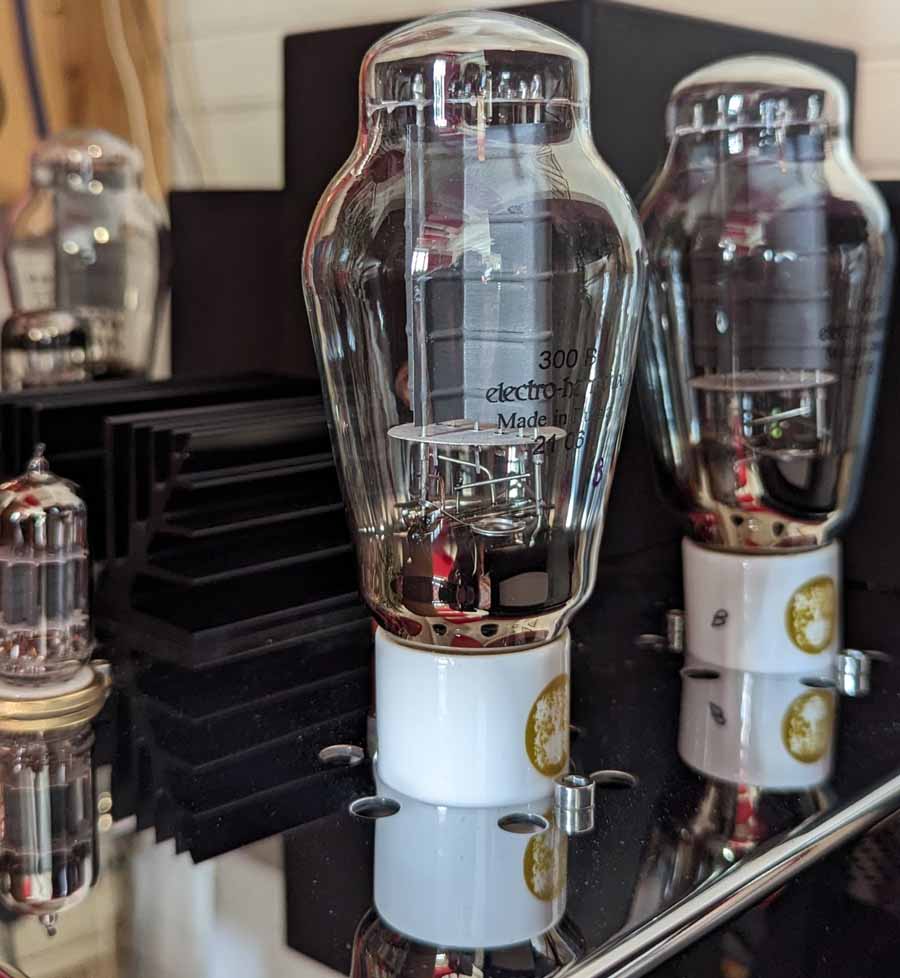
A closer look at those 300Bs.
Neil Young’s When You Dance from Live Rust has this amplifier bringing out the distortion on the guitar really well and with a grit and (again) texture to it that brings that edge-of-your-seat playing style that Young has to the fore. It’s almost as if he’s going to lose it and then he brings that overdriven sound back from the brink and controls it. Of course, this is always there and the amp isn’t adding something that isn’t already there. What this amp does do, however, is allow the texture (again… sorry) to really shine out and I found myself looking/listening into that sound and being drawn into it. It’s very difficult to explain, but I’d say that the I300 is somehow connecting with something in my unconscious that my ears/brain really like to hear. The Merrill Thor amps we have are perhaps just as accurate (perhaps more so) than the JADIS, but the JADIS is, to my ears, a far superior amp for listening and putting a big grin on your face. This opens up a whole discussion, I know, and for me, it questions the whole validity of judging sound systems based purely on the way they measure when we as human beings listen and interact with that music and that system. In short, something else is going on over and above whether a product measures “correctly”. Whether the system I’m listening to and with this amplifier in place measures as some would want it to, I don’t give a monkey’s toss – it’s giving me a whole bagful of joy and that has to be a good thing!
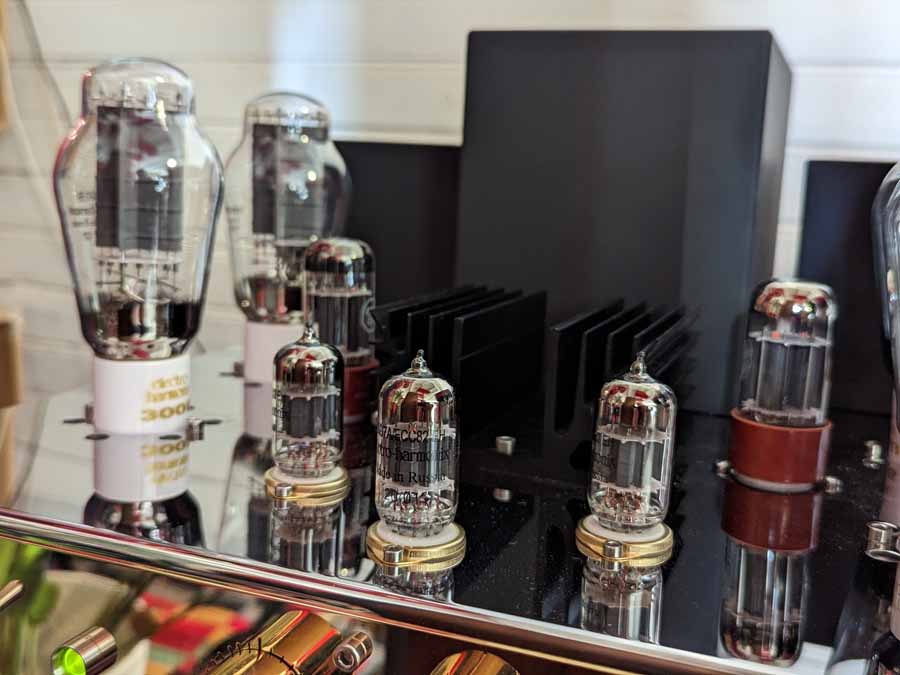
Another shot of the I300 showing it in all its finery.
I put on Todd Terry’s Resolutions album specifically for the first track, Blackout. This is a track that really should sound best on a clinical and cold system – it’s all steely drum and thunderous bass – but on again with this amp in place there is nothing but a feeling of rightness to the music I’m listening to. It’s free of harshness but still has that hard hitting and visceral quality across the (very broad) frequency range. Again, this amp just keeps on going and offers up a dynamic and yet nuanced listening experience – there’s a sound bendy effect on the tom (I think) at 4’06” and for a bit after that goes somewhat to demonstrate to me that this amp is conveying a whole load of detail to the speakers in a manner that they can make sense of and deliver to me in my listening seat. I get the same sense of rightness listening to the frantic programming of Squarepusher on his Ufabulum record – speed, depth, space and texture.
QUIBBLES
The remote is a bit pants and isn’t in keeping with the rest of the amplifier.
If you are looking for an amplifier that is absolutely neutral in its presentation then you may want to go and listen to something else – but don’t discount this as once bitten forever smitten and all that.
CONCLUSION
A build quality that is commensurate with the asking price of this amplifier makes this a real jewel of a product with regards to it as an object even before you plug it in and play your tunes. The remote should be taken out and shot to put it out of its misery, though, to be fair, it’s better than some I’ve had with kit and does its job well enough – at least it says JADIS on it!
Once you do plug it in and start to listen to music it’s MUSIC that you end up listening to. It’s not got any “etched” or hyper-detailed quality to its sonic signature, but then it is very detailed – it’s just that that detail is delivered through the speakers in a manner that allows you to relax. Think a glass of well-rounded, room temperature Bordeaux red over a steely cold white Chablis.
The character of this amplifier is dynamic and yet restrained, detailed but without being overly in your face, and it’s got control of the bass without adding bloat or artifacts.
Would I buy it? Yep, at the drop of an AMEX card. I loved it very much!
Editors Choice award without a shadow of a doubt and I find myself looking for excuses to buy it!
AT A GLANCE
Build Quality:
Impossible to make any negative comment about the build of this amplifier
It’s gold and it’s blingy. Some will love it and others will hate it
Remote is not in keeping with the build of the amplifier
Balance control is an excellent thing to include
Sound Quality:
This amplifier isn’t warm in that pipe and slippers (boring?) sense, it’s got a well rounded character that oozes class and refinement
Bass is excellently controlled and right
Mids are wonderfully smooth and yet defined
Tops are clear and in keeping with the character of the rest of the amplifier
Overall it is a well-balanced amplifier that somehow connects the listener with the music they are listening to
Value For Money:
It’s a lot of money but you could spend a lot more and do a lot worse
We Loved:
The way it connects listeners with music
Complete lack of harshness
Plenty of drive and dynamics
Excellent bass handling with the speakers I tried it with
Allows the speakers to throw an excellent soundstage that is stable and natural
We Didn’t Love So Much:
The remote
I imagine that with speakers much less sensitive than I tried it could struggle to deliver at high volume
Valves aren’t going to be cheap to replace
Elevator Pitch Review: The I300 amplifier from French brand JADIS is an integrated based around a pair of 300B tubes in push/pull configuration. It’s only got ten watts per channel but I found it drove all the speakers I tried it with well loud enough, though those with particularly difficult to drive speakers will no doubt need to look elsewhere. It has five line level inputs and its controls include a balance control which I think is a useful addition.
I don’t know how this measures with regards to the measurements that some think indicates an accurate and therefore good amplifier… and I don’t care. When listening to this amplifier I feel connected to the music I’m listening to on a really basic and human level. It bounces along with techno music and allows you to see into the recording without it being in-your-face analytical in character. In short, it is a refined and accomplished performer across the audio spectrum and with all kinds of music.
Price: €13 500

Stuart Smith
SPECIFICATIONS
Power 10W – Classe A
Input/Output 5 lines, 1 Bypass output, 2 loudspeakers outputs (for bi-wiring)
Bandwidth 20Hz to 55kHz
Sensitivity 100mV
Tubes 4 x 300B, 2 x 6SN7, 3 x ECC82
Dimensions 40 x 40 x25,5 cm
Weight 40kg
Consumption 200 VA












































